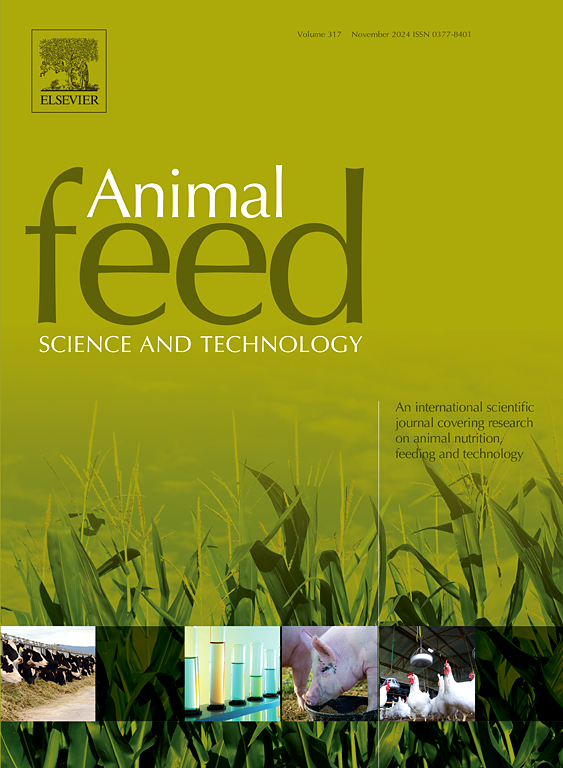The anti-methanogenic efficacy of Asparagopsis taxiformis: Could it be attributable solely to its bromoform content?
IF 2.5
2区 农林科学
Q1 AGRICULTURE, DAIRY & ANIMAL SCIENCE
引用次数: 0
Abstract
The seaweed Aspragopsis taxiformis has been shown to be a successful intervention to mitigate methane (CH4) emissions from ruminants due to the content of halogenated components, including bromoform. Some groups have been exploring extracting or synthesizing bromoform to be used as a feed additive rather than using whole seaweed biomass. This study was conducted to understand the differences between whole A. taxiformis biomass and bromoform in their ability to reduce CH4 production when included in ruminant diets. A series of in vitro experiments were conducted, with a control group consisting of a 50 % hay:50 % concentrate. A. taxiformis biomass supplementation levels of 0.25 and 0.50 %, containing 0.0037 and 0.0077 mg bromoform on a dry matter (DM) basis, respectively, were evaluated. Bromoform was evaluated at 0.0018, 0.0036, and 0.0073 mg. The two highest levels of bromoform were comparable to the bromoform content in the seaweed biomass. Adding A. taxiformis biomass led to significant reductions in CH4 yield (mL/g) of 62.5 and 95.6 %, respectively, without compromising in vitro fermentation characteristics. The addition of bromoform resulted in a decrease in the CH4 yield (mL/g) by 7.6, 23.0, and 59.6 %, respectively. In conclusion, while bromoform led to a dose-dependent reduction in CH4 production, A. taxiformis has a greater effect at equivalent doses of bromoform, suggesting that the other components in the biomass, which were responsible for up to 40 % of the reduction, play a significant role in the anti-methanogenic efficiency of A. taxiformis.
Asparagopsis taxiformis 的抗甲烷化功效:这是否仅仅归因于其溴甲烷含量?
海藻 Aspragopsis taxiformis 含有包括溴甲烷在内的卤化成分,已被证明是一种成功的干预措施,可减少反刍动物的甲烷(CH4)排放。一些研究小组一直在探索提取或合成溴甲烷作为饲料添加剂,而不是使用整个海藻生物质。本研究旨在了解在反刍动物日粮中添加整个 A. taxiformis 生物质和溴甲烷时,它们在减少甲烷(CH4)产生方面的能力差异。研究人员进行了一系列体外实验,对照组由 50% 干草:50% 精料组成。评估了 0.25% 和 0.50% 的 A. taxiformis 生物量补充水平,按干物质(DM)计算,分别含有 0.0037 和 0.0077 毫克溴甲烷。溴甲烷的含量分别为 0.0018、0.0036 和 0.0073 毫克。最高的两个溴甲烷含量与海藻生物质中的溴甲烷含量相当。在不影响体外发酵特性的情况下,添加 A. taxiformis 生物质可使 CH4 产量(毫升/克)分别显著降低 62.5% 和 95.6%。添加溴甲烷则导致 CH4 产率(毫升/克)分别降低了 7.6%、23.0% 和 59.6%。总之,虽然溴甲烷导致 CH4 产量的减少与剂量有关,但在同等剂量的溴甲烷中,A. taxiformis 的作用更大,这表明生物质中的其他成分在 A. taxiformis 的抗甲烷生成效率中发挥了重要作用,这些成分最多可导致 40% 的减少。
本文章由计算机程序翻译,如有差异,请以英文原文为准。
求助全文
约1分钟内获得全文
求助全文
来源期刊

Animal Feed Science and Technology
农林科学-奶制品与动物科学
CiteScore
6.00
自引率
6.20%
发文量
266
审稿时长
3 months
期刊介绍:
Animal Feed Science and Technology is a unique journal publishing scientific papers of international interest focusing on animal feeds and their feeding.
Papers describing research on feed for ruminants and non-ruminants, including poultry, horses, companion animals and aquatic animals, are welcome.
The journal covers the following areas:
Nutritive value of feeds (e.g., assessment, improvement)
Methods of conserving and processing feeds that affect their nutritional value
Agronomic and climatic factors influencing the nutritive value of feeds
Utilization of feeds and the improvement of such
Metabolic, production, reproduction and health responses, as well as potential environmental impacts, of diet inputs and feed technologies (e.g., feeds, feed additives, feed components, mycotoxins)
Mathematical models relating directly to animal-feed interactions
Analytical and experimental methods for feed evaluation
Environmental impacts of feed technologies in animal production.
 求助内容:
求助内容: 应助结果提醒方式:
应助结果提醒方式:


